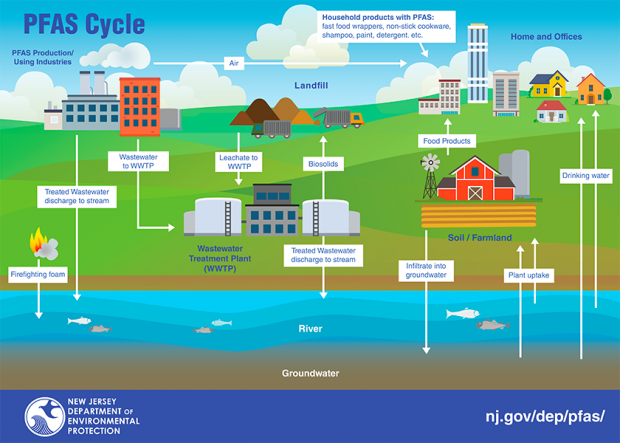New Jersey Future Blog
PFAS in the Garden State: What It Is and What We’re Doing About It
November 11th, 2022 by New Jersey Future staff
By Hannah Reynolds and Brianne Callahan
If the increased prevalence of the term “perfluoroalkyl” has you scratching your head, you’re not alone! Read on to learn about per- and polyfluoroalkyl substances (PFAS), why you should care, and what we’re doing about it here in New Jersey.
Perfluoro- what?!
In addition to being incredibly difficult to pronounce, per- and polyfluoroalkyl substances (PFAS) are a large class of human-made chemicals that repel water and oil and are resistant to heat and chemical reactions. Two of the most prevalent PFAS compounds are perfluorooctanoic acid (PFOA) and perfluorooctane sulfonate (PFOS). They are commonly used in commercial and manufacturing applications, and unfortunately they are becoming more and more infamous as they are linked to serious health effects for humans and animals.
Manufacturing of PFAS chemicals began in the 1940s, to create non-stick cookware, firefighting foam, and many other common products including detergents, fast-food wrappers, paints, and even beauty products. Most famously, PFAS chemicals are present in DuPont’s teflon cookware—a fact your grandparents could most assuredly corroborate.
Why You Should Care
There’s no sugarcoating it—PFAS pose a big problem. These chemicals are linked to serious health issues for humans and animals alike, and they are wreaking havoc on communities across the United States. Known as “forever chemicals,”contaminants in the PFAS family accumulate in the body over extended periods of time, and are associated with a higher risk of health problems including liver damage, thyroid disease, decreased fertility, high cholesterol, obesity, hormone suppression, and cancer. PFAS can pass into our bodies through water, food, and air, and their usage is widespread. It is found in food packaging and textiles, is sprayed on agricultural fields through biosolids, and it seeps into groundwater at commercial sites, airports and military bases. Widely accepted estimates indicate that one-third of Americans drink water contaminated with PFAS, though more recent studies suggest that exposure to PFAS may be much higher.
New Jersey is no exception. In fact, New Jersey is among the top three states, behind Michigan and California, in the prevalence of PFAS. A 2015 study of Northeast waterways—the first to examine endocrine disruption in US national wildlife refuges— indicated estrogenic contaminants like PFAS were present in the water, having feminizing effects on male fish. Just last year, six towns in the Garden State discovered unsafe levels of PFAS in their drinking water. PFAS chemicals are estimated to be present in the drinking water of roughly 6% of 9.2 million New Jerseyans, with 34 community-based and 40 non-community-based water systems exceeding state thresholds for safe levels of consumption impacting over 500,000 people. Our densely-populated state is particularly vulnerable to PFAS and other toxic chemicals in our water, especially with high rates of waste, landfills, and industrial manufacturing contributing to high levels of PFAS in the water.
One of the biggest difficulties that PFAS presents is its impact on water utilities. In many cases, water utility companies are tasked with the burden of monitoring and reporting levels of PFAS in the drinking water, while simultaneously facing the consequences when levels of PFAS exceed the state and national thresholds. Utilities often must alert the public of unsafe levels, which can create alarm and tarnish the utilities’ public image; clean up the contamination or find a new supply of water; and pay the costs of both monitoring and cleanup—all the while not being responsible for the contamination in the first place. More often than not, these costs fall upon both utilities and the public’s water bills.

What New Jersey Is Doing To Protect Public Health
New Jersey leadership has been incredibly responsive and proactive in addressing PFAS contamination. The New Jersey Department of Environmental Protection (NJDEP) recently established strict standards for PFAS in drinking water, as the first state to adopt a maximum contaminant level (MCL) for PFAS. New Jersey has an MCL for a few PFAS compounds: 14 parts per trillion (ppt) for PFOA and 13 ppt for PFOS. As of last year, the state requires all public water systems to be monitored for these chemicals. If you learn that PFAS have been detected in your drinking water above the New Jersey MCL, consult the current recommendations for limiting exposure from the US-EPA here.
In addition, the state is addressing the source of PFAS. In 2019, the NJDEP ordered five companies (3M, DuPont, DowDuPont, Chemours, and Solvay) to pay millions of dollars for cleanup of PFAS under the Spill Act, demonstrating the capacity for the state to enforce such measures and ensure adequate cleanup takes place. We need New Jersey’s strong leadership to continue as the state addresses this pervasive threat to environmental and public health.
Next Steps
Though we’ve gotten a good start here in New Jersey, there is much to do with regards to PFAS. A number of opportunities exist to address PFAS through investment in technology, funding for water quality remediation and treatment efforts, advocacy for stricter policy at the state level, enforcement of strict monitoring for contaminant levels, and holding polluters accountable. In Wisconsin, an innovative study lends us hope, as it has shown great success in decreasing concentrations of PFAS in the soil through the use of microbes which break down the compound. With the announcement of $1 billion of the state budget allocated to water infrastructure over the next five years, there are opportunities to direct funding to equip wastewater treatment facilities with the capacity to target PFAS and other contaminants in the water. At the same time, advocating for stricter standards for PFAS at the federal level can help to keep Americans safer from PFAS, following the model of New Jersey, which has one of the strictest limits on PFAS levels in the country. Currently, there is no national MCL, but the EPA recently proposed setting enforceable MCLs of 4 parts per quadrillion (ppq) for PFOA and 20 ppq for PFOS. A nationwide standard would also set the groundwork for enforcing PFAS limits under federal policy. Further, it is important to take steps to hold polluters accountable, requiring that those responsible for PFAS pay for remediation– not utilities or taxpayers. The bottom line is that keeping our communities safe from PFAS isn’t going to be easy, but if we work together and focus on transparency and creative solutions, keeping New Jersey waterways clean and healthy is attainable.
Related Posts
Tags: contamination, drinking water, forever chemicals, health, per- and polyfluoroalkyl substances, PFAS, public health, safety, Water, water systems
















